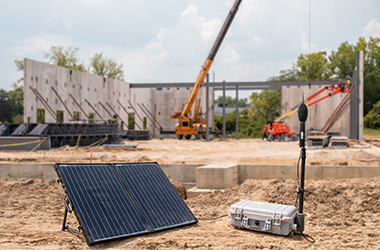Main Menu
- Home
- Product Finder
- Calibration Systems
- Calibration Services
- Digital Sensing
- Industrial Vibration Calibration
- Modal and Vibration Testing
- Non-Destructive Testing
- Sound & Vibration Rental Program
- Learn
- About Us
- Contact Us

Need to perform a short-term noise measurement? Want to try out a new product? Or only have operational budget available for your project? Renting a noise monitoring system is a great option.
Outdoor noise monitoring systems rented from The Modal Shop are highly customizable. All include a meter, power source, and environmentally protected enclosure. See the charts below for available systems, microphones, preamplifiers, and more. Contact our team with any questions or for guidance on which system best fits your needs. All kits come with Larson Davis Integrating Sound Level Meters capable of:
Note: 831C- and 821ENV-based models are recommended. Legacy LxT and 831 models may be available to match existing systems.
| Kit Model | Base Meter Model | 1/1 and/or 1/3 Octave Bands | Event Sound Recording | Solar Panel | Tripod Included | Remote Connection | Weather Sensor |
|---|---|---|---|---|---|---|---|
| NMS044‑SLA100 | 831C | ✓ | ✓ | ✓ | Built-in | ✓ | Optional |
| NMS‑831C‑L | 831C | - | - | Optional | ✓ | Optional | Optional |
| NMS‑831C | 831C | ✓ | - | Optional | ✓ | Optional | Optional |
| NMS‑831C‑H | 831C | ✓ | ✓ | Optional | ✓ | Optional | Optional |
| KNMS048 | 821ENV | ✓ | ✓* | - | Built-in | - | - |
| KNMS048-SLA | 821ENV | ✓ | ✓* | ✓ | Built-in | - | - |
*Sound recording option included with rental configurations, optional when purchased.
Free Field – Designed to be used when the field of measurement is open and not filled with hard, reflective surfaces (in other words, when the measurement is being taken in an open area). There are two ways of using a free-field microphone:
Random Incidence – Designed to measure a sound field with multiple sources in multiple directions. Random incidence microphones react equally to pressure waves from every direction in reflective areas. Typical applications include
Pressure Field - Designed to measure the sound pressure in front of the diaphragm, pressure microphones typically allow for a greater dynamic range and have a very flat response across the full frequency spectrum. The pressure microphones offered by TMS for rent feature low sensitivity that allows the noise monitoring system to measure higher dB levels without overloading.
Note that 831C and 821ENV meters can apply measurement corrections to account for a specific microphone or the presence of an environmental shroud.
Learn more about available microphones.
| Microphone Description | Model Number | Response |
|---|---|---|
| General Purpose (Traffic, etc.) | 377B02 | Free Field |
| High Level (Factory, etc.) | 377C10 | Pressure Field |
| Extremely High Level (Ballistics at near range, etc.) | 377A12 | Pressure Field |
| Random Incidence to Full Hearing Range (For reverberant spaces and inside vehicles) | 377A21 | Random Incidence |
| Extremely Low Level (National Parks, sanctuaries, etc.) | 378A04 | Free Field |
*Microphone range varies with the meter used, preamplifier, etc. Contact our rental team for more details.
| Purpose | Model Number |
|---|---|
| For 831C meters | PRM831 |
| For 821ENV meters | PRM821 |
| Use | Battery Type | Model Number | Battery Life (display off) |
|---|---|---|---|
| Handheld with 831C | 4x Internal Alkaline AA Batteries | 8 h | |
| Handheld with 831C | 4x Internal Lithium AA Batteries | 18 h | |
| Handheld with 821ENV | Built-in Rechargeable Battery | 40 h | |
| Short Term with 831C and Weatherproof Case | 8x D cell | EPS042 | 5 d |
| Short Term with 821ENV and Weatherproof case | 12x D cell | 821-P3 | 10 d |
| Short Term with 821ENV and Weatherproof Case | 21AH SLA Battery (BAT011) | 821-P2 | 12 d |
| Continuous with Solar 821ENV or 831C and Weatherproof Case | Solar panel with 21AH SLA battery (BAT011) | EPS044 | continuous when solar insolation > 2kW•h/m2/day |
| Type of Connection | Model Number |
|---|---|
| WiFi for close proximity wireless (e.g., when the meter is in a fenced area or on a high pole) | DVX014 |
| Cellular Modem for temporary or permanent installations with wireless gateway and data SIM | COM‑RV50‑DC‑U |
| USB to Ethernet Adaptor for permanent Ethernet-based data connection | DVX012 |
| USB Multi Port hub for multiple USB devices, including connectivity, USB storage, GPS, and more | DVX015 |
Various weather parameters can be collected and synced with other measured data. Parameters that can be measured may include wind speed, gust speed, direction, temperature, humidity, and barometric pressure. The Modal Shop rents these sensors as kits (denoted by the "K" prefix in the model number). Kits include
| Purpose | Model Number | Wind (Speed & Direction) | Temperature | Humidity | Barometric Pressure | Rain Rate | Hail Rate |
|---|---|---|---|---|---|---|---|
| Multi‑parameter | KSEN031 | ✓ | ✓ | ✓ | ✓ | ✓ | ✓ |
| Wind speed and direction | KSEN032 | ✓ | - | - | - | - | - |
| Purpose | Model Number |
|---|---|
| Monopod | NMS044 and NMS048, Built-in to system |
| Light-duty, short-term use for attended measurements | TRP001 |
| Heavy-duty, unattended tripod | TRP003 |